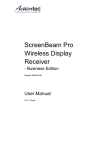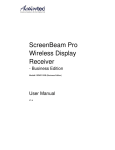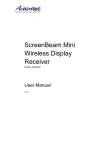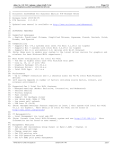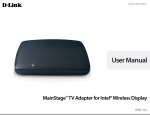Download ScreenBeam Pro Wireless Display Receiver
Transcript
ScreenBeam Pro
Wireless Display
Receiver
- Business Edition
Model#: SBWD100B
User Manual
V0.4 (Based on firmware v2.2.11.0)
Table of Contents
Part I.
Getting Started ......................................................................................................................1
1.1. Contents in the Box ...........................................................................................................1
1.2. Meeting ScreenBeam Pro .................................................................................................2
1.3. System Requirements .......................................................................................................2
1.3.1.
Receiver .................................................................................................................2
1.3.2.
Compatible Devices...............................................................................................2
Part II. Installing the Receiver ...........................................................................................................3
2.1. Connecting the Receiver to an HDTV ................................................................................3
Part III. Setting Up for the First Time .................................................................................................5
3.1. Connecting via Windows 8.1 .............................................................................................5
3.2. Connecting via Intel WiDi App ..........................................................................................8
3.2.1.
Adjusting the HDTV Picture .................................................................................11
3.2.2.
Intel WiDi Software Version Support ..................................................................13
3.3. Connecting via Miracast™ ...............................................................................................14
3.4. Tips for Optimal Performance .........................................................................................14
Part IV. Control and Display .............................................................................................................15
4.1. Intel Pro WiDi and Managed Meeting.............................................................................15
4.2. Display Mode ..................................................................................................................16
4.3. Ultra-Low Delay ...............................................................................................................16
4.3.1.
Intel WiDi.............................................................................................................17
Part V. Device Management for IT Administrator...........................................................................18
5.1. Log into the Local Management Web Server ..................................................................18
5.1.1.
When Autonomous GO is Enabled ......................................................................18
5.1.2.
When Autonomous GO is Disabled .....................................................................19
5.2. Log Out ............................................................................................................................20
5.3. Configuring the Receiver .................................................................................................21
5.3.1.
Renaming the Receiver .......................................................................................21
5.3.2.
Changing the Local Management Server Login Username and Password ..........21
5.3.3.
Changing the Receiver’s Display Language .........................................................22
5.3.4.
Setting up Network Information Display on TV Screen .......................................23
5.3.5.
Setting up Autonomous Group Owner (AGO) .....................................................24
5.3.6.
Setting up Group Owner Intent ...........................................................................25
5.3.7.
Setting up Managed Meeting..............................................................................25
5.3.8.
Setting up Communication Channel....................................................................26
5.3.9.
Setting up P2P Network Parameters ...................................................................27
5.3.10. Setting up Wireless Network Parameters ...........................................................28
5.3.11. Setting up Ethernet IP Parameters ......................................................................29
5.3.12. Setting up WiDi Lower Bandwidth ......................................................................30
5.3.13. Setting up HDCP Encryption ................................................................................31
5.3.14. Setting up PIN Pairing Method ............................................................................32
5.3.15. Setting up USB Local Access ................................................................................33
5.3.16. Managing HDMI Port Output ..............................................................................34
5.3.17. Adjusting TV Screen Size .....................................................................................35
5.3.18. Updating the Receiver’s Background Image .......................................................35
5.3.19. Updating the Receiver’s Screensaver Image .......................................................36
5.3.20. Rebooting the Receiver .......................................................................................38
5.3.21. Resetting the Receiver to Default........................................................................38
5.4. Upgrading the Receiver ...................................................................................................39
Part I. Getting Started
Thank you for your purchase of Actiontec’s ScreenBeam Pro Wireless Display Receiver
Business Edition (hereinafter refer to as “ScreenBeam Pro”).
The Receiver lets you wirelessly stream what’s on your Intel WiDi or Miracast™ compatible
device to your HDTV, including movies, videos, photos, music, and more. The Receiver frees
your eyes from a tiny screen.
The Receiver boasts some great features, including fast setup, enhanced security and IT
manageability, managed meeting (Gen 5 WiDi), smooth video playback, full 1080p HD
support, ultra-low delay, Windows 8.1 optimization, versatile compatibility, low power
consumption, and more.
With ScreenBeam Pro, it's easy to make presentations and impromptu meetings in the
conference room a breeze, as users don't need to scramble to find the right HDMI or VGA
cable in order to share a spreadsheet or presentation on the big screen. And the Managed
Meeting feature allows meeting participants to interactively share their own screens on the
big screen.
This user manual will take you through the procedures needed to install, connect to, operate,
configure, and upgrade the Receiver, and also describe a few different possible scenarios
about locating faults.
1.1. Contents in the Box
Contents in the Receiver’s package are listed below:
ScreenBeam Pro Wireless Display Receiver (SBWD100B) - Business Edition (1)
HDMI Cable (1)
HDMI-to-VGA Adapter & 3.5mm audio cable (1)*
AC Power Adapter (1)
Installation Guide
* Only available for Catalog # SBWD100BE02
1
1.2. Meeting ScreenBeam Pro
Reset Button, for resetting the device to default
Video Out Port (HDMI), connecting to HDTV/projector for video and audio output
Power Input Port, for powering the device
LED Indicator, indicating power supply status
USB Port, for firmware upgrade
1.3. System Requirements
System requirements for the receiver are shown below:
1.3.1. Receiver
To install the Receiver, you must have the following items:
A display device with one HDMI port (Type A) or one VGA port
An available power outlet
1.3.2. Compatible Devices
The Receiver is compatible with the following devices:
Laptop or notebook with Intel WiDi 4 or higher
Smartphone, tablet, or laptop running Windows 8.1
Wi-Fi Certified Miracast™ smartphones and tablets
Non WiDi/Miracast ready laptops and PCs with Actiontec USB Transmitter (Windows 7
or higher)
2
Part II. Installing the Receiver
This chapter explains how to connect the Receiver to an HDTV. Make sure you have all the
contents from the Receiver’s package available before starting.
2.1. Connecting the Receiver to an HDTV
It is quite easy and fast to set up the Receiver. You can complete the connection in just one
minute.
To connect the Receiver to an HDTV:
1. Get the Receiver, AC power adapter, and HDMI cable from the Receiver’s package.
2. Plug one end of the supplied HDMI cable into the HDMI port (Video Out) on the Receiver,
and the other end into an available HDMI port on the HDTV.
3. Plug the connector of the power cord to the Receiver’s power input port labeled "Power",
and plug the power adapter to a power outlet.
When Steps 1, 2, and 3 are complete, the hardware should be connected as shown in
the figure below:
4.
5.
Turn on the HDTV and set it to display the input from the correct HDMI port (the one you
have plugged into in Step 2).
Verify that the “Ready to connect” screen appears on the HDTV.
3
The Receiver is connected to the HDTV, and it is ready for use.
Note: Connections to other display devices are similar.
4
Part III.
Setting Up for the First
Time
This chapter explains how to connect ScreenBeam Pro for the first time to the source device.
There are three source device options: Intel WiDi, Windows 8.1, and Miracast™.
For Windows 8.1 devices, please proceed to Section “Connecting via Windows 8.1”;
For Windows 7/8 devices, please proceed to Section “Connecting via Intel WiDi App”;
For Android devices, please proceed to Section “Connecting via Miracast™”.
3.1. Connecting via Windows 8.1
This section explains how to connect a device running Windows 8.1 to ScreenBeam Pro.
1. From the Windows desktop, go to the Charms menu and select Devices to open the
Devices menu. You can also use the shortcut keys, Windows logo + K.
2.
From the Devices menu, click Project.
3.
From the Project menu, select Add a wireless display. Windows will search for
available devices.
5
Note: If you are running Windows 8.1 and the screens above do not appear, go to
http://www.actiontec.com/widi81 for the latest software update. Or, you can update your
Windows 8.1 via the Windows Update application.
4. Select your receiver from the device list.
5.
A PIN entry box is displayed on the screen of your Windows 8.1 device. And you can
see a PIN code and the host name (QA-PC01 in this example) of the connecting device
displayed on the HDTV. Type the PIN in the PIN entry box and click Next to continue.
Note: You should obtain the security PIN from your network administrator if no PIN is
displayed on the connected display device.
6
7
6.
The HDTV displays messages to show the status of the connection.
7.
The device has connected to the Receiver. And the device’s screen is displayed on the
HDTV.
3.2. Connecting via Intel WiDi App
This section explains how to connect a device running Intel's WiDi application to the Receiver.
Note: For more information about connecting an Intel Pro WiDi device to the receiver, refer
to Section 4.1. Intel Pro WiDi and Managed Meeting.
Follow the procedure below to connect your device to the Receiver:
1. Launch the Intel Wireless Display application on the device. To find the application, go
8
2.
3.
to Windows Search on the device and search for “Intel WiDi”.
The Intel WiDi application scans for available receivers automatically. Select your
receiver and click Connect. (The “Connect Automatically” checkbox is optional.)
Note: If your receiver is not found, you can click the Scan button to scan again.
A PIN entry box is displayed on the screen of the WiDi device. And you can see a PIN
code and the host name (QA-PC01 in this example) of the connecting device displayed
on the HDTV. Type the PIN in the PIN entry box on the WiDi device, and then click
Continue.
Note: You should obtain the security PIN from your network administrator if no PIN is
displayed on the connected display device.
9
4.
The HDTV displays messages to show the status of the connection.
10
5.
A "Connection Successful" screen appears on the device's screen. Click Finished,
and the device’s screen is displayed on the HDTV.
3.2.1. Adjusting the HDTV Picture
If edges of the device screen cannot be seen on the HDTV or you can see black edges, you
can adjust the cropping settings.
11
Follow the steps below to adjust cropping:
1. Go to the Intel WiDi application and click the Settings button to open the Settings page.
2.
Go to the "Picture and Sound" section, and select “Adjust cropping”.
3.
Adjust the HDTV picture by clicking “+” (plus) or “-” (minus).
12
3.2.2. Intel WiDi Software Version Support
Make sure the device supports Intel Wireless Display (WiDi) software version 3.5 or higher.
To find out which version of Intel WiDi the device is running, launch the Intel WiDi
application and click the Help button, and then navigate to the "About Intel® WiDi" section.
To obtain the latest Intel WiDi software and drivers, go to:
http://www.intel.com/go/wirelessdisplayupdate; or directly click the Check Intel® WiDi
website for updates link on the page.
13
3.3. Connecting via Miracast™
This section explains how to connect a Miracast™-enabled Android device, such as a
smartphone, a tablet, or a game console, to ScreenBeam Pro. For the best performance, the
Miracast™ device should be running the latest software.
1. On a Miracast™-enabled Android device, locate and open the Wireless Display
Application (check for the application under “Settings”).
Note: The name of the Wireless Display application depends on the device type and
model. Refer to the device's user manual for more details.
2. The Wireless Display application scans for available devices. Select your receiver from
the device list. You may be required to enter a PIN code.
Note:
You should obtain the security PIN from your network administrator if no PIN is
displayed on the connected display device. By default, the security PIN is
“12345670”.
If a PIN is displayed on the connected display device, you should type this PIN in
the PIN entry box.
Some Android devices do not support the PIN paring method. In this case, the
IT/admin needs to disable the Force PIN Pairing feature. To do that, refer to 5.3.14.
Setting up PIN Pairing Method.
3. Type the PIN in the PIN entry box and tap Connect to continue.
4. Wait for the device to pair with and connect to your receiver. When it does, the device's
screen will be displayed on the HDTV.
3.4. Tips for Optimal Performance
For optimal performance, you can try these tips:
•
Keep the Receiver within line-of-sight of the source device. Doing this will help ensure
the Receiver receives the best possible signal.
•
The Receiver's optimal wireless range is within 30 feet from the source device. However,
actual range and effectiveness depends on many factors, including other sources of
interference and the building materials used in the surrounding structure.
•
Avoid placing the receiver near wireless interference sources, such as electric fans,
items with motors, microwave ovens, cordless phones.
14
Part IV. Control and Display
This chapter describes the display modes and control options that are supported by the
Receiver.
4.1. Intel Pro WiDi and Managed Meeting
ScreenBeam Pro supports the Managed Meeting feature, which is provided with Intel Pro
WiDi (Gen 5). The Managed Meeting feature allows meeting participants to share their
screens interactively, or allow the owner (the first connected user who has set the interactive
mode to “I can request others to present”) to manage other participants.
There are three meeting modes available when the Managed Meeting function is enabled.
Only I present. No one else can share or take control.
Others can request to present. Other people can request control/sharing.
I can request others to present. You control sharing.
Note: To use these meeting modes, you must enable the Managed Meeting function in the
local management server. Refer to Section 5.3.7. Setting up Managed Meeting for details.
Note: The Gen 5 Intel WiDi (WiDi 5.x.x.x) requires the Haswell systems.
Note: For detailed operation and related information about Intel Pro WiDi, refer to
http://www.actiontec.com/prowidi.
15
4.2. Display Mode
The Receiver supports three display modes when connected with a compatible wireless
display application (Intel WiDi or Windows 8.1 Project, for example).
In Windows, press the Windows logo and P keys simultaneously (
display options and select the desired display mode from the options.
+ P) to launch the
Duplicate
The Duplicate mode is used to display the same content on both the device's screen and
the HDTV simultaneously.
Note: There may be minor delay between the content displayed on the HDTV screen
compared to the device’s screen. This is due to the current state of wireless display
technology.
Extend
The Extend mode creates a single, extended "screen" between the source device and the
HDTV. When in the Extend mode, dragging windows to the right side of the device's screen
displays those windows on the HDTV, while dragging windows to the left of the HDTV screen
displays them back on the device's screen. This mode allows users to display selected
content on the HDTV, while all other windows remain on the device's screen. When this mode
is first selected, the HDTV displays only the Windows desktop.
Second Screen Only
The Second Screen Only mode causes the HDTV to be the only display for the device.
You’ll see everything on the connected screen, and your device’s screen will be blank.
4.3. Ultra-Low Delay
The Receiver also supports ultra-low delay, which helps reduce end-to-end wireless display
latency. Real-time applications, such as games, can run without noticeable delay when the
Ultra-Low Delay mode is enabled on supported devices.
16
4.3.1. Intel WiDi
You can activate Ultra-Low Delay on a device running Intel WiDi 3.5 or higher. Follow the
steps below to switch to ultra-low delay mode:
1. Launch the Intel WiDi application, connect to the receiver you are using, and then click
the Settings button.
2.
On the "Settings" screen, select Current Display Settings.
3.
Select Prioritize Speed in the "Quality vs. Speed" section and click the Apply Settings
button. Refer to Intel's support documentation for more information.
17
Part V. Device Management for IT
Administrator
ScreenBeam Pro provides a local management web server to manage the device. With the
web server, IT administrators can setup, configure and upgrade the receiver.
5.1. Log into the Local Management Web Server
There are two methods to log into the local management web server.
5.1.1. When Autonomous GO is Enabled
When Autonomous GO is enabled, you can log into the local management web server
through "http://192.168.16.1". You must connect your device to the receiver, and then access
the URL address with a web browser.
Note: http://192.168.16.1 is the default URL address. You can modify this URL address in
the local management web page. Refer to Section 5.3.9. Setting up P2P Network
Parameters for detail.
Follow the procedure below to log into the local management server when AGO is enabled.
1. Connect your device to ScreenBeam Pro.
2. Access the URL address (http://192.168.16.1) with a web browser on your device.
3. The web server login interface appears. Type the username and password in the
Username and Password boxes and click the Login button.
Note:
By default, the Username is “Administrator” and Password is “WiDi”. You can modify
the username and password in the local management web page. Refer to Section 5.3.2.
Changing the Local Management Server Login Username and Password for detail.
The username and password are case sensitive.
When Autonomous GO is enabled, the SSID of the receiver doesn’t work.
18
5.1.2. When Autonomous GO is Disabled
When Autonomous GO is disabled, you must connect your device to the receiver’s SSID,
and then access the URL address with a web browser.
Note: You can set the network to be displayed on the Ready to connect screen. Refer to
Section 5.3.4. Setting up Network Information Display on TV Screen for detail.
Follow the procedure below to log into the local management web server:
1. Connect to the receiver’s SSID from a wireless-enabled laptop (or other devices with WiFi access ability and a web browser). You can find the SSID in the lower part of the Ready
to connect screen.
Note: If the network information display is disabled, you can find the SSID of the receiver on
the Wi-Fi connection list by following these tips: the SSID of the receiver is in this format
“Actiontec-SBWD-xxxxxx”, and the last four characters are the same as the last four of the
receiver name.
2. Click the wireless network icon to open the Networks page, and select the receiver’s
SSID.
Note: You can modify this SSID and its password in the local management web page. Refer
to Section 5.3.10. Setting up Wireless Network Parameters for detail.
3. The Connect to a Network window appears. Type the network security key in Security
key box of the Connect to a Network dialog box. Click OK to continue.
Note: By default, the network security key is “12345678”.
19
Note: You can modify this SSID and its password in the local management web page. Refer
to Section 5.3.10. Setting up Wireless Network Parameters for detail.
4. Access the URL address ("http://192.168.51.1" in this example) with a web browser on
the laptop.
Note: You can modify this URL address in the local management web page. Refer to Section
5.3.10. Setting up Wireless Network Parameters for detail.
5. The web server login interface is displayed. Type the username and password in the
Username and Password boxes and click the Login button.
Note:
By default, the Username is “Administrator” and Password is “WiDi”. You can modify
the username and password in the local management web page. Refer to Section 5.3.2.
Changing the Local Management Server Login Username and Password for detail.
The username and password are case sensitive.
5.2. Log Out
To log out from the web server, go to the Logout tab page and click the “Yes” button to log
out.
20
5.3. Configuring the Receiver
After you have logged into the web server, you can configure ScreenBeam Pro on the
webpage.
5.3.1. Renaming the Receiver
1. Go to the Device Configuration tab page by clicking the Device Configuration tab.
2. Set the Device Name Access to Enable.
3. Type a new name in the Device Name box.
4. Click the Apply button, and then click OK on the pop-up message box to confirm.
5.3.2. Changing the Local Management Server Login Username and
Password
You can modify the user name and password for logging into the local management server.
1. Go to the Device Configuration tab page by clicking the Device Configuration tab.
21
2. Type new username and password in the Administrator Username and Administrator
Password boxes.
3. Click the Apply button, and then click OK on the pop-up message box to confirm.
5.3.3. Changing the Receiver’s Display Language
1. Go to the Device Configuration tab page by clicking the Device Configuration tab.
2. Choose a desired language from the Display Language drop-down box.
Currently available languages are Dutch, English, French, Japanese, Korean, Simplified
Chinese, Traditional Chinese, Spanish, and German.
Note: This will change the language display on the TV screen and not on the configuration
webpage.
3. Click the Apply button, and then click OK on the pop-up message box to confirm.
22
5.3.4. Setting up Network Information Display on TV Screen
Follow the procedure below to set up the receiver’s network information display:
1. Go to the Network Settings tab page by clicking the Network Settings tab.
2.
To enable/disable the Show network information on TV screen feature, go to the
Show network information on TV screen line, and set the feature to Enable or
Disable.
Note: By default, this feature is disabled, that is network information is not displayed.
3. Click the Apply button, and then click OK on the pop-up message box to confirm.
After the network information display is enabled, network information is shown on the TV
screen.
23
5.3.5. Setting up Autonomous Group Owner (AGO)
The Autonomous Group Owner function (enabled) allows the receiver to be the group owner
during a p2p connection negotiation. In this case, the receiver can determine the channel for
communication.
In a Wi-Fi P2P group, the group owner operates as an access point and all other devices are
clients. After AGO is enabled, the receiver works as the P2P group owner.
1. Go to the Network Settings tab page by clicking the Network Settings tab.
2. Set the Autonomous Group Owner (AGO) to Enable or Disable.
There are two options: Enable and Disable.
Enable: The communication channel can be defined by the receiver. And access control
on managed meeting and channel selection is available.
Disable: Access control on managed meeting and channel selection is not available. In
this case, the communication channel will be consistent with the source device, or be
determined through negotiation between the receiver and the connecting device.
24
Note: By default, AGO is enabled.
3. Click the Apply button, and then click OK on the pop-up message box to confirm.
4. The receiver reboots, and new settings take effect after the reboot.
5.3.6. Setting up Group Owner Intent
When the AGO function is disabled, the Group Owner Intent function is available. The
Group Owner Intent function is used to determine which device (receiver or connecting
device) will be the group owner.
1. Go to the Features tab page by clicking the Features tab.
2. Properly configure the Group Owner Intent value and click the Apply button.
Note: The larger the value is, the more likely the receiver becomes the group owner of the
P2P connection.
3. Click the Apply button, and then click OK on the pop-up message box to confirm.
4. The receiver reboots, and new settings take effect after the reboot.
5.3.7. Setting up Managed Meeting
The Managed Meeting is available when AGO is enabled. There are two options: Enable
25
and Disable.
Enable: The Managed Meeting function is available.
Disable: The Managed Meeting function is not available.
The Managed Meeting function allows meeting participants to share the wireless display
interactively.
For more information about Managed Meeting, refer to Section 4.1. Intel Pro WiDi and
Managed Meeting.
1. Go to the Features tab page by clicking the Features tab.
2. To enable/disable Managed Meetings, set the Managed Meetings function to
Enable/Disable.
3. For better communication, you can define a port (Managed Meetings Port) for the
Managed Meeting, as shown below:
4. Click the Apply button, and then click OK on the pop-up message box to confirm.
5. The receiver reboots, and new settings take effect after the reboot.
5.3.8. Setting up Communication Channel
When AGO is enabled, you can define a channel for communication between the wireless
display receiver and the source device.
1. Go to the Network Settings tab page by clicking the Network Settings tab.
2. Select a desired channel from the Channel Number drop-down box.
26
Channels from 1 to 11 belong to the 2.4 GHz band; and channels from 36 to 165 belong to
the 5 GHz band.
You should select a channel based on your network environment. Generally, cleaner
channels (where less devices work) will provide better performance.
3. Click the Apply button, and then click OK on the pop-up message box to confirm.
5.3.9. Setting up P2P Network Parameters
When AGO is enabled, you can define network parameters for peer to peer connection,
including P2P Wireless Network Name (SSID), Password, IP address, subnet mask, DHCP
IP address range.
1. Go to the Network Settings tab page by clicking the Network Settings tab.
2. Properly configure the network parameters.
27
P2P Wireless Network Name (SSID) and P2P Wireless Network Password:
Reserved.
P2P IP Address: It is the IP address of the receiver in a peer to peer connection. This
IP address is displayed in the bottom left corner of the Ready to connect screen. It is
used to access the local management server when AGO is enabled.
P2P Subnet Mask: It is the subnet mask for the network established in the peer to peer
connection.
P2P DHCP IP Start and P2P DHCP IP End: These two items define the range of IP
addresses assigned to the connected devices.
Note: These network parameters works when AGO is enabled.
3. Click the Apply button, and then click OK on the pop-up message box to confirm.
4. The receiver reboots, and new settings take effect after the reboot.
5.3.10. Setting up Wireless Network Parameters
When AGO is disabled, you can define wireless network parameters for local management
web server, including wireless network name (SSID) and password, IP address, and subnet
mask.
1. Go to the Network Settings tab page by clicking the Network Settings tab.
2. Properly configure the network parameters.
28
Wireless Network Name (SSID) and Wireless Network Password: The SSID and
password for accessing the receiver’s wireless network. The SSID is displayed when
AGO is disabled.
Wireless IP Address: It is the IP address of the local management web server. This IP
address is displayed in the lower part of the Ready to connect screen. It is used to
access the local management server when AGO is disabled.
Wireless Subnet Mask: It is the subnet mask of receiver’s network.
Wireless DHCP IP Start and Wireless DHCP IP End: These two items define the range
of IP addresses assigned to the connected devices.
Note: These network parameters works when the AGO is disabled.
3. Click the Apply button, and then click OK on the pop-up message box to confirm.
4. The receiver reboots, and new settings take effect after the reboot.
5.3.11. Setting up Ethernet IP Parameters
The Ethernet Interface Setting is used to configure the Ethernet IP address for the
29
connected USB-to-Ethernet adapter.
Follow the procedure below to modify the receiver’s Ethernet IP address:
1. Go to the Network Settings tab page by clicking the Network Settings tab.
2.
Type an IP address in the IP Address box and a new subnet address in Subnet Mask
box.
Note: When a USB-to-Ethernet adapter is connected to the receiver, this IP address is
displayed in the lower part of the Ready to connect screen. Users can use this IP address
to access the local management server.
3. Click the Apply button, and then click OK on the pop-up message box to confirm.
4.
The receiver reboots, and new settings take effect after the reboot.
5.3.12. Setting up WiDi Lower Bandwidth
The WiDi Lower Bandwidth is used to control video quality and speed.
Follow the procedure below to set up WiDi Lower Bandwidth for the receiver:
1. Go to the Features tab page by clicking the Features tab.
2. Set WiDi Lower Bandwidth to Enable or Disable according to practical requirements.
There are two options: Enable and Disable.
Enable: This will limit the bandwidth for WiDi. In a congested network, this can produce
relatively smooth video playback.
Disable: The bandwidth for WiDi is not limited. This will produce better video quality for
video playback when working in a clean network.
30
3. Click the Apply button, and then click OK on the pop-up message box to confirm.
5.3.13. Setting up HDCP Encryption
The HDCP Encryption feature can improve connection speed and compatibility when it is
disabled.
Follow the procedure below to set up HDCP encryption:
1. Go to the Features tab page by clicking the Features tab.
2. Select an option for the HDCP Encryption feature.
There are two options available: Enable, and Disable.
Enable: This option is default. HDCP encryption is enabled to protect HDCP
protected media.
Disable: Disabling the HDCP Encryption function will improve connection speed
and compatibility. However, you cannot play HDCP protected media.
3. Click the Apply button, and then click OK on the pop-up message box to confirm.
4. The receiver reboots, and new settings take effect after the reboot.
31
5.3.14. Setting up PIN Pairing Method
For security purpose, you may be required to connect to ScreenBeam Pro with a PIN. You
can define the PIN pairing method in the local management page.
Follow the procedure below to set up PIN pairing methods:
1. Go to the Features tab page by clicking the Features tab.
2. Set the Force PIN Pairing on First Connection feature to On or Off.
Select "Off" to disable the PIN enforcement function. PIN entry or PBC is used when
connecting your device to the receiver for the first time.
Select "On" to enable the PIN enforcement function. In this case, you must enter a
PIN code on the device connecting to the receiver for the first time. When this
function is enabled, the system provides two PIN generation methods: Random
and Static.
Note: Some wireless display source device may not support PIN entry and may not
be able to connect with the ScreenBeam receiver if this mode is enabled. Refer to
the device’s user manual for detail about enabling the PIN connection.
Random: A PIN code is generated randomly by the system and displayed on
the connected HDTV/projector.
Static: Users can define seven (7) digits, and then the system generates an
eight (8) digit PIN with that seven digits included.
Enter seven (7) digits in the Static box, click the "Apply" button, and the
system generates an eight (8) digit PIN and display it on the Static PIN field.
This PIN will not be displayed on the connected display.
3. Click the Apply button, and then click OK on the pop-up message box to confirm.
32
5.3.15. Setting up USB Local Access
A USB port is provided on the ScreenBeam Pro wireless display receiver for multi-purpose
uses. You can set up the USB port in the local management page.
Follow the steps below to set up the USB port:
1. Go to the Features tab page by clicking the Features tab.
2.
Configure the USB Local Access feature according to practical requirements.
There are three options: Disable, Only allow firmware update, and Enable.
Disable: Select "Disable" to disable the USB port on the receiver.
Only allow firmware update: Select "Only allow firmware update" to allow users to
upgrade the receiver's firmware through the USB port.
Enable: Select "Enable" to allow full functions of the USB port. In this case, users not
only can upgrade the receiver, but also can control the source device by connecting a
keyboard/mouse to the receiver via the USB port (with the User Input Back Channel
(UIBC) or USB over IP (UoIP) function enabled).
UIBC: The connected keyboard/mouse does not support combo keys or mouse
right-click.
UoIP: The connected keyboard/mouse supports full functions.
Note: UoIP is compatible with Intel WiDi only.
Click the Apply button, and then click OK on the pop-up message box to confirm.
3.
33
5.3.16. Managing HDMI Port Output
The HDMI Port Power management feature provides flexible options to control the HDMI
outputs.
1. Go to the Features tab page by clicking the Features tab.
2. Select the desired option in the HDMI Port Power management drop-down box.
There are three options: Always On, Screensaver, and HDMI Off.
Always On: Selecting this option, the HDMI output is always on.
Screensaver: Selecting this option, the system will run the screensaver after the defined
idle time expires. Users can define the idle time in the Wait time box.
HDMI Off: Selecting this option, the HDMI output will be turned off after the defined idle
time expires. Users can define the idle time in the Wait time box.
3. Click the Apply button, and then click OK on the pop-up message box to confirm.
34
5.3.17. Adjusting TV Screen Size
If edges of the device screen cannot be seen on the HDTV or you can see black edges, you
can adjust the TV screen size (overscan).
1. Go to the Features tab page by clicking the Features tab.
2. Select a desired option in the TV Screen Size (Overscan Settings) drop-down box.
3. Click the Apply button, and then click OK on the pop-up message box to confirm.
5.3.18. Updating the Receiver’s Background Image
Follow the procedure below to update the receiver’s background:
1. Go to the Features tab page by clicking the Features tab.
2. Go to the Background Image line, and click the Browse button next to the Background
Image box.
3. The Choose File to Upload window appears. Select an image for the background and
35
click the Open button to confirm.
Note:
The images must be in .png and .jpeg/.jpg formats.
The file size must not exceed 2.5 MB.
The best image size is 1280*720 pixels (width x height).
4. Click the Apply button to upload the background image to the receiver.
5. A confirmation message appears. Click OK to continue.
6. After a while, the background image will be updated. You can check it on the connected
display.
5.3.19. Updating the Receiver’s Screensaver Image
Follow the procedure below to update the receiver’s screensaver:
1. Go to the Features tab page by clicking the Features tab.
36
2. Go to the Screen Saver Image line, and click the Browse button next to the Screen
Saver Image box.
3. The Choose File to Upload window appears. Select an image for the screensaver and
click the Open button to confirm.
Note:
The image must be in .png format.
The file size must not exceed 200 KB.
The best image size is 300*60 pixels.
4. Click the Apply button to upload the screensaver image to the receiver.
5. A confirmation message appears. Click OK to continue.
37
6. After a while, the screensaver image will be updated. You can check it on the connected
display when the screensaver is running.
5.3.20. Rebooting the Receiver
Follow the procedure below to reboot the receiver:
1. Go to the Maintenance tab page by clicking the Maintenance tab.
2. Click the Yes button next to “Reboot Receiver”.
3. Click OK on the pop-up message box to confirm.
5.3.21. Resetting the Receiver to Default
Follow the procedure below to reset the receiver to the default settings:
1. Go to the Maintenance tab page by clicking the Maintenance tab.
38
2. Click the Yes button next to “Reset Settings to Factory”.
3. Click OK on the pop-up message box to confirm.
4. The receiver reboots, and the receiver is reset to factory defaults after the reboot.
Note: You can also reset your receiver to default by pressing the "Reset" button. Follow the
procedure below to restore the Receiver's default factory settings:
1. Power on the Receiver, and wait until the "Ready to Connect" screen appears.
2. Hold down the Receiver's "Reset" button with a pin.
3. When the "Reset to Default" screen appears on the HDTV, release the "Reset" button.
The Receiver reboots, and it will be running with its default settings.
5.4. Upgrading the Receiver
ScreenBeam Pro supports firmware upgrade. And Actiontec’s ScreenBeam team will
constantly improve the receiver’s performance with new firmware.
Follow the procedure below to upgrade your receiver:
1. Log into ScreenBeam Pro’s web server, and go to the Firmware Upgrade tab page by
clicking the Firmware Upgrade tab.
On the Firmware Upgrade tab page, you can check the current firmware version in the
Firmware Version section and upgrade the receiver.
39
2. Select Enable in the Firmware Update box.
3. Download the latest firmware from Actiontec’s website:
http://www.actiontec.com/sbupdate.
Note: You should disconnect from the receiver’s SSID and connect to a router’s SSID
before downloading firmware.
4. Extract the zip file. You will find one "autorun" folder and one "install.img" file in the
extracted file folder.
5. Insert a USB flash drive to your laptop/PC.
6. Copy the "autorun" folder and the "install.img" file to the root directory of the USB flash
drive.
Note: Do not use a portable hard drive. You should use a FAT/FAT32 formatted USB
flash drive only.
7. Power on your Receiver. Make sure the "Ready To Connect" screen appears on your
TV.
Note: You must disconnect your device (laptop, ultrabook, smartphone or tablet) from
the receiver before upgrading your receiver.
8. Safely remove your USB flash drive from your PC, and plug it into the USB port of
ScreenBeam Pro.
9. The Receiver starts to update its firmware automatically. Firmware upgrade status
messages appear on your TV.
Warning! Do not power off the Receiver or remove the USB flash drive while the
upgrade is in progress. Otherwise, firmware upgrade fails.
10. The Receiver reboots. Firmware upgrade completes after the "Ready To Connect"
screen appears again.
11. Upgrade completes. You may now remove the USB flash drive from the Receiver.
40











































